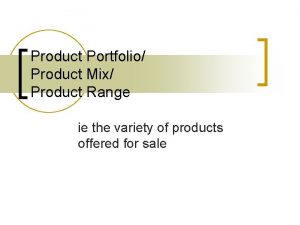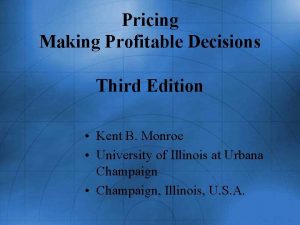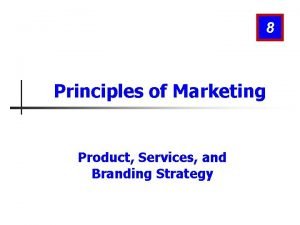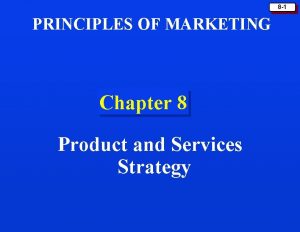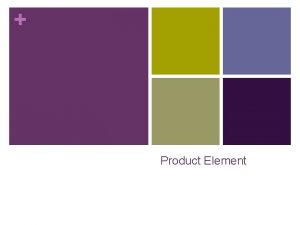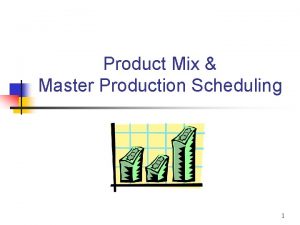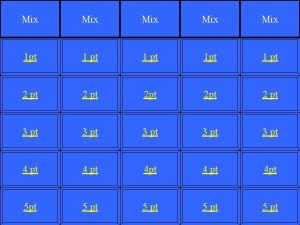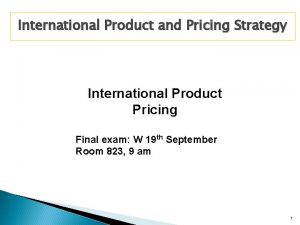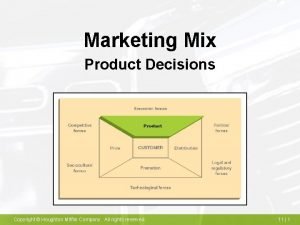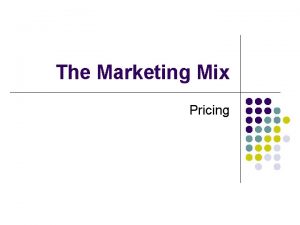Chapter 19 Pricing and product mix decisions Copyright






























- Slides: 30

Chapter 19 Pricing and product mix decisions Copyright 2003 Mc. Graw-Hill Australia Pty Ltd, PPTs t/a Management Accounting: An Australian Perspective 3/e by Langfield-Smith, Thorne & Hilton Slides prepared by Kim Langfield-Smith

Major influences on pricing decisions s s Market positioning Product cost Customer value Competitor behaviour Legal, political and ethical issues s Cost forms the lower limit of the price, and customer value the upper limit Copyright 2003 Mc. Graw-Hill Australia Pty Ltd, PPTs t/a Management Accounting: An Australian Perspective 3/e by Langfield-Smith, Thorne & Hilton Slides prepared by Kim Langfield-Smith 2

Copyright 2003 Mc. Graw-Hill Australia Pty Ltd, PPTs t/a Management Accounting: An Australian Perspective 3/e by Langfield-Smith, Thorne & Hilton Slides prepared by Kim Langfield-Smith 3

Major influences on pricing decision s Market positioning ÙCompanies position themselves in certain markets and this may influence product prices ÙA firm with a reputation for very high quality and prestigious products may set a high price, consistent with that image ÙAn overemphasis on price cutting can damage a product’s image, and reduce profitability continued Copyright 2003 Mc. Graw-Hill Australia Pty Ltd, PPTs t/a Management Accounting: An Australian Perspective 3/e by Langfield-Smith, Thorne & Hilton Slides prepared by Kim Langfield-Smith 4

Major influences on pricing decisions s Product costs ÙIn the long-term firms must produce at a cost below selling price ÙThe importance of product cost in price setting varies across industry ÙEven when a firm sets a price below cost, it is still important to have an awareness of product cost continued Copyright 2003 Mc. Graw-Hill Australia Pty Ltd, PPTs t/a Management Accounting: An Australian Perspective 3/e by Langfield-Smith, Thorne & Hilton Slides prepared by Kim Langfield-Smith 5

Major influences on pricing decisions s Customer value ÙUnderstanding customer value is a critical aspect in price setting ÙThe difference between the value that a customer gains by owning and using a product, and the price paid for the product ÙBusinesses must understand the specific aspects of a product or service that provide value to the customer continued Copyright 2003 Mc. Graw-Hill Australia Pty Ltd, PPTs t/a Management Accounting: An Australian Perspective 3/e by Langfield-Smith, Thorne & Hilton Slides prepared by Kim Langfield-Smith 6

Major influences on pricing decisions s Competitors' behaviour ÙCompetitors’ behaviour can effect a company’s pricing decisions ÙWhen considering the reaction of competitors management must take care to define its product and market correctly ÙPredicting competitors’ reactions to its products and pricing strategy is a difficult but important task for management continued Copyright 2003 Mc. Graw-Hill Australia Pty Ltd, PPTs t/a Management Accounting: An Australian Perspective 3/e by Langfield-Smith, Thorne & Hilton Slides prepared by Kim Langfield-Smith 7

Major influences on pricing decisions s Legal, political and ethical issues ÙManagers must adhere to the laws when setting prices ÙThe law generally prohibits companies from discriminating between customers in setting prices ÙPolitical pressures may lead to intervention in the setting of prices ÙEthical considerations may need to be considered, including deceptive practices Copyright 2003 Mc. Graw-Hill Australia Pty Ltd, PPTs t/a Management Accounting: An Australian Perspective 3/e by Langfield-Smith, Thorne & Hilton Slides prepared by Kim Langfield-Smith 8

Economic profitmaximising models s Economic model focus on the optimal price and sales quantity that will maximise profit s Price elasticity is the impact on price changes on sales volume s Cross elasticity is the extent to which a change in a product’s price can affect the demand for a substitute product continued Copyright 2003 Mc. Graw-Hill Australia Pty Ltd, PPTs t/a Management Accounting: An Australian Perspective 3/e by Langfield-Smith, Thorne & Hilton Slides prepared by Kim Langfield-Smith 9

Economic profitmaximising models s Demand is elastic if a price increase has a large negative impact on sales volume s Demand is inelastic if a price change has little or no impact on sales quantity Copyright 2003 Mc. Graw-Hill Australia Pty Ltd, PPTs t/a Management Accounting: An Australian Perspective 3/e by Langfield-Smith, Thorne & Hilton Slides prepared by Kim Langfield-Smith 10

Limitations of the economic model s Difficult to precisely determine the firm’s demand curve and marginal revenue curve s Many factors affect product demand s Not valid for all forms of markets s Difficulty of measuring marginal cost—most costing systems are not designed to do this Copyright 2003 Mc. Graw-Hill Australia Pty Ltd, PPTs t/a Management Accounting: An Australian Perspective 3/e by Langfield-Smith, Thorne & Hilton Slides prepared by Kim Langfield-Smith 11

Pricing strategies s Value based pricing ÙWhere customers’ perceptions of the value of the product or service guide the pricing s Economic value pricing ÙSpecifically estimates the costs and benefits experienced by the customer, which extend beyond the initial purchase price ÙOften used in industrial markets Copyright 2003 Mc. Graw-Hill Australia Pty Ltd, PPTs t/a Management Accounting: An Australian Perspective 3/e by Langfield-Smith, Thorne & Hilton Slides prepared by Kim Langfield-Smith 12

Using product costs in pricing s Product costs are used, to some degree, to set prices ÙDifficult to do thorough market analysis for all products—need quick, straightforward methods to set price ÙCosts give management a starting point ÙCost provides a floor below which price cannot be set in the long run Copyright 2003 Mc. Graw-Hill Australia Pty Ltd, PPTs t/a Management Accounting: An Australian Perspective 3/e by Langfield-Smith, Thorne & Hilton Slides prepared by Kim Langfield-Smith 13

Cost-plus pricing s Cost-based pricing formulas ÙPrice = cost + (mark-up percentage x cost) s Mark-up percentage is dependent on the type of costing used s Two issues ÙWhat is the best definition of cost to be used in the cost-plus pricing formula? ÙHow is the desired mark-up determined? Copyright 2003 Mc. Graw-Hill Australia Pty Ltd, PPTs t/a Management Accounting: An Australian Perspective 3/e by Langfield-Smith, Thorne & Hilton Slides prepared by Kim Langfield-Smith 14

Product costing definitions s Absorption cost pricing formulas ÙProvide a justifiable price—perceived to be equitable to all parties ÙUsually provided by a firm’s costing system— cost-effective to use in pricing ÙDisadvantages v. Obscures the cost behaviour patterns of the firm v. Not consistent with CVP analysis continued Copyright 2003 Mc. Graw-Hill Australia Pty Ltd, PPTs t/a Management Accounting: An Australian Perspective 3/e by Langfield-Smith, Thorne & Hilton Slides prepared by Kim Langfield-Smith 15

Product costing definitions s Variable cost pricing formulas ÙDoes not obscure the cost behaviour pattern by unitising fixed costs ÙVariable cost data is useful for short-term pricing decisions ÙDisadvantages v. In the long-term prices must be set to cover all costs and a normal profit margin v. Managers must use high mark-up when using variable cost Copyright 2003 Mc. Graw-Hill Australia Pty Ltd, PPTs t/a Management Accounting: An Australian Perspective 3/e by Langfield-Smith, Thorne & Hilton Slides prepared by Kim Langfield-Smith 16

Determining the mark-up s Return on investment pricing ÙSelling price determined by using the required rate of return to determine the mark-up on cost Average investment x target ROI = target profit Copyright 2003 Mc. Graw-Hill Australia Pty Ltd, PPTs t/a Management Accounting: An Australian Perspective 3/e by Langfield-Smith, Thorne & Hilton Slides prepared by Kim Langfield-Smith 17

Mark-up percentage Copyright 2003 Mc. Graw-Hill Australia Pty Ltd, PPTs t/a Management Accounting: An Australian Perspective 3/e by Langfield-Smith, Thorne & Hilton Slides prepared by Kim Langfield-Smith 18

Time and material pricing s Cost-plus pricing using separate labour and materials charges s Labour charge includes a charge for labourrelated overhead and profit margin s Material charge includes a charge for material-related overhead continued Copyright 2003 Mc. Graw-Hill Australia Pty Ltd, PPTs t/a Management Accounting: An Australian Perspective 3/e by Langfield-Smith, Thorne & Hilton Slides prepared by Kim Langfield-Smith 19

Time and material pricing Copyright 2003 Mc. Graw-Hill Australia Pty Ltd, PPTs t/a Management Accounting: An Australian Perspective 3/e by Langfield-Smith, Thorne & Hilton Slides prepared by Kim Langfield-Smith 20

Cost-plus pricing: summary and evaluation s Effective price setting requires a constant interplay of ÙMarket considerations ÙCost awareness s Cost-plus pricing may be used to establish a pricing starting point continued Copyright 2003 Mc. Graw-Hill Australia Pty Ltd, PPTs t/a Management Accounting: An Australian Perspective 3/e by Langfield-Smith, Thorne & Hilton Slides prepared by Kim Langfield-Smith 21

Cost-plus pricing: summary and evaluation s Cost-plus pricing formulas: ÙSimple ÙCan be applied mechanically ÙAllow managers to update prices for multiple products ÙCan be used with a variety of cost definitions s Mark-up percentages should take account of the cost definitions Copyright 2003 Mc. Graw-Hill Australia Pty Ltd, PPTs t/a Management Accounting: An Australian Perspective 3/e by Langfield-Smith, Thorne & Hilton Slides prepared by Kim Langfield-Smith 22

The role of ABC in pricing s Conventional volume-based product costing systems may distort costs between product lines s ABC ÙMeasures the extent to which each product consumes costs of key support activities ÙWill provide more accurate cost figures on which to base prices Copyright 2003 Mc. Graw-Hill Australia Pty Ltd, PPTs t/a Management Accounting: An Australian Perspective 3/e by Langfield-Smith, Thorne & Hilton Slides prepared by Kim Langfield-Smith 23

Strategic pricing of new products s The newer the concept of the product, the more difficult the pricing decision s Skimming pricing ÙA high initial product price to reap high shortterm profits on a new product ÙOver time, the price will be lowered s Penetration pricing ÙA low initial price of a new product to attract market share Copyright 2003 Mc. Graw-Hill Australia Pty Ltd, PPTs t/a Management Accounting: An Australian Perspective 3/e by Langfield-Smith, Thorne & Hilton Slides prepared by Kim Langfield-Smith 24

Competitive bidding s Two or more companies submit sealed bids (or prices) for a product, service or project, to a potential buyer s Similar considerations as for accepting or rejecting a special order s Excess capacity ÙIf price > incremental costs of producing the product, will contributes towards the company’s fixed cost and profit continued Copyright 2003 Mc. Graw-Hill Australia Pty Ltd, PPTs t/a Management Accounting: An Australian Perspective 3/e by Langfield-Smith, Thorne & Hilton Slides prepared by Kim Langfield-Smith 25

Competitive bidding s No excess capacity ÙIncremental costs still relevant ÙOpportunity costs must be assessed ÙA bid price should cover the opportunity cost ÙThe bid price may be higher than when excess capacity exists s Qualitative and strategic issues need to be considered Copyright 2003 Mc. Graw-Hill Australia Pty Ltd, PPTs t/a Management Accounting: An Australian Perspective 3/e by Langfield-Smith, Thorne & Hilton Slides prepared by Kim Langfield-Smith 26

Legal restrictions on pricing s Australian Competition and Consumer Commission (ACCC) has power to outlaw the following behaviours ÙPredatory pricing ÙPrice discrimination ÙResale price maintenance ÙPrice-fixing contracts Copyright 2003 Mc. Graw-Hill Australia Pty Ltd, PPTs t/a Management Accounting: An Australian Perspective 3/e by Langfield-Smith, Thorne & Hilton Slides prepared by Kim Langfield-Smith 27

Product mix decisions s Determining the most appropriate range of products to offer to consumers s Product mix decisions are linked to pricing as prices influence ÙProfitability ÙCustomer behaviour and competitors reactions Copyright 2003 Mc. Graw-Hill Australia Pty Ltd, PPTs t/a Management Accounting: An Australian Perspective 3/e by Langfield-Smith, Thorne & Hilton Slides prepared by Kim Langfield-Smith 28

Tactical product mix decisions with limited resources s Tactical product mix ÙUse contribution margin per unit of the scarce resource, not contribution margin per unit ÙConsider implications of the decision on customer behaviour and competitor reactions s Limited resources may include floor-space, machine time, raw materials, labour hours s Multiple scarce resources use linear programming Copyright 2003 Mc. Graw-Hill Australia Pty Ltd, PPTs t/a Management Accounting: An Australian Perspective 3/e by Langfield-Smith, Thorne & Hilton Slides prepared by Kim Langfield-Smith 29

Long-term product mix decisions s All relevant costs are considered in the final decision s Loss-making products, firms can choose to ÙIncrease product price ÙTry to reduce the cost of the product ÙOffer customer incentives ÙRetain the product as it is part of a range ÙDiscontinue the product Copyright 2003 Mc. Graw-Hill Australia Pty Ltd, PPTs t/a Management Accounting: An Australian Perspective 3/e by Langfield-Smith, Thorne & Hilton Slides prepared by Kim Langfield-Smith 30
 Decisions decisions decisions poster
Decisions decisions decisions poster Cost plus pricing formula
Cost plus pricing formula Product mix vs marketing mix
Product mix vs marketing mix Optional product pricing meaning
Optional product pricing meaning Product line depth
Product line depth Product range vs product mix
Product range vs product mix Screening decisions and preference decisions
Screening decisions and preference decisions Pricing and output decisions in perfect competition
Pricing and output decisions in perfect competition Pricing decision and cost management
Pricing decision and cost management Factors influencing pricing
Factors influencing pricing Pricing: making profitable decisions
Pricing: making profitable decisions Brand and product decisions in global marketing
Brand and product decisions in global marketing Global product planning strategic alternatives
Global product planning strategic alternatives Individual product and service decisions
Individual product and service decisions Product safety and pricing
Product safety and pricing International product decisions
International product decisions Setting product
Setting product Product line decisions
Product line decisions Product line decisions
Product line decisions Elements of product mix
Elements of product mix Types of services marketing
Types of services marketing Chapter 8 marketing
Chapter 8 marketing Product price place
Product price place Marketing mix starbucks
Marketing mix starbucks Product width
Product width Green marketing meaning
Green marketing meaning Product mix width
Product mix width Width vs depth
Width vs depth Product marketing mix
Product marketing mix Coke vs pepsi products
Coke vs pepsi products Contraction of product mix
Contraction of product mix





